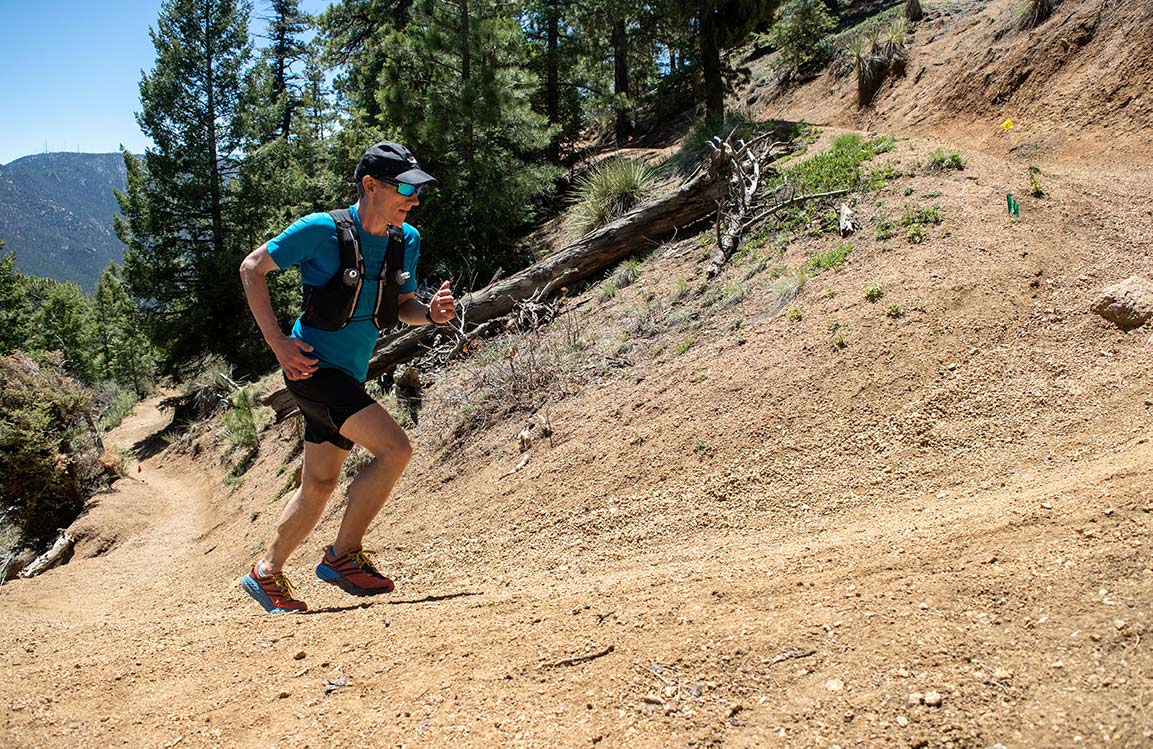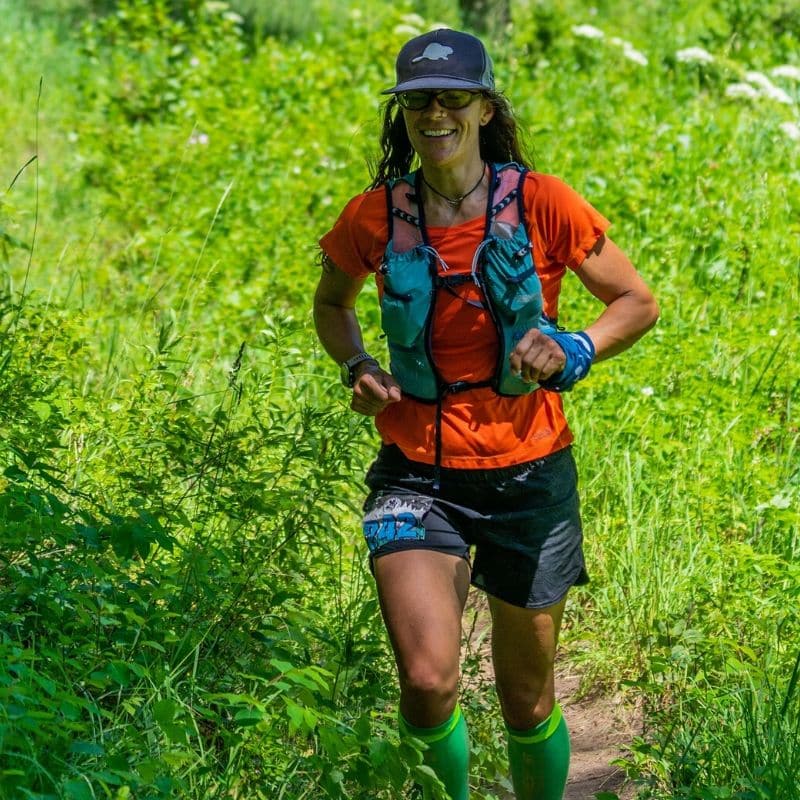
Training to Run Uphill Faster
By Darcie Murphy,
CTS Ultrarunning Pro Coach
Ultrarunning combines a multiple skills and abilities, from knowing how to handle yourself in the elements in remote areas, to understanding how to fuel your body for many hours or days while in motion. Typically, ultrarunning includes substantial climbs and descents and a lot of cumulative elevation change. To become better at something, we must practice it, and that applies to training for uphill running. So, let’s examine ways to improve your ability to run uphill more effectively.
Captain Obvious: “Run Hills”
First and most obvious: run hills consistently, ideally on a variety of inclines. If you tend to stick to flat terrain, map out routes that cover a range of elevation gains. By having preplanned routes by elevation gain, it’s simple math to choose routes and gradually increase your weekly climbing. To a certain extent, spending more time on climbs will make you better at going uphill.
If you genuinely don’t have mountains or hills near you, it’s time for creativity. Consider overpasses or even parking garages to create the climbing stimulus you need. Treadmills are a terrific tool for the vertically challenged. Ultrarunners sometimes loathe treadmill training, but if you’re serious about improving your uphill running, embrace the highly focused opportunities treadmills provide. The potential downside to treadmills is that the deck may not simulate downhill running. As a result, you’ll miss out on adaptations to downhill running. Fortunately, those it only takes a little bit of downhill running to achieve most of those adaptations, as explained in this post. Today, however, we’ll stick to making you a better uphill runner.
Shorten your stride and use your upper body
On uphills it’s advantageous to shorten your stride and use your upper body to propel you forward and upward. Placing your feet slightly closer together each time they strike the ground creates a mechanical advantage. In turn, this allows you to utilize your posterior kinetic chain muscles (think of your glutes). At the same time, you’ll improve your agility for the lateral movements necessary for negotiating obstacles like roots and rocks. Exaggerating your arm drive keeps you in balance and enhances upward momentum against gravity.
Do your best to keep your hands from crossing your midline because that becomes less mechanically advantageous. Instead, drive your hands forward and backward in an amplified manner so you are moving uphill with more power and speed. Keep in mind that a shorter, quicker stride combined with increased upper body drive will probably increase your breathing and heart rate. That’s okay, you’re improving your cardiovascular fitness while also activating the powerhouse of your posterior kinetic chain, both of which will improve your uphill running capability.
Strengthen posterior kinetic chain
Speaking of the posterior kinetic chain muscles, strong glutes, back, abdominal muscles and hamstrings are key to being a strong uphill runner. Focusing time on improving the strength of these muscle groups creates more uphill power. It may also help improve your overall durability as an athlete, creating a body that is less injury prone. How exactly should you improve your strength for these muscle groups? While a periodized strength program is beyond the scope of this article, a reasonable starting point is to review this article from CTS Coach Sarah Scozzaro.
Ultrarunners can improve their climbing ability by integrating some basic year-round strength exercises that complement their running. The bridges, deadlifts, lateral exercises, abdominal strength and balance work mentioned in Sarah’s article are excellent foundational movements that add strength to your uphill running. Additional measures may include plyometric exercises, box/stair step ups, and lunge variations.
The intricate details of how integrate strength training for your posterior muscles can be somewhat complicated. Typically, an ultrarunner should aim to consolidate their hardest training sessions into a relatively short time span, carving plenty of time for recovery between the challenging bouts. Completing a strength session within 3-24 hours following a dedicated uphill training session is usually effective timing. Be sure there is adequate nutritional replenishment between the hill running workout and the strength workout.
Delay the transition to hiking
During ultrarunning events runners often hike significant uphill portions. This is especially true for longer ultramarathons. From a specificity standpoint, hiking is an important component of training when you know you’ll be hiking during competition. However, it’s also important – in training – to run on grades you may hike during a long race.
Don’t automatically switch to hiking every time you approach an incline that you would hike during a race. Instead, push yourself to continue running, even when it’s uncomfortable and your inner voice says you should switch to hiking. As you start running up grades that you historically hike, you develop the ability to continue running on steeper inclines. Long term, this helps you move faster over entire hilly routes. The idea isn’t necessarily to run every single uphill section in an event, regardless of distance or incline. Rather, by increasing the range of grades you can run, you will move uphill more economically and comfortably.
From a scheduling standpoint, training to expand the grades you can effectively run should happen early in your plan. As you approach your event, your hiking/running behaviors should become more specific to your race plan.
Structured workouts for uphill running
A more structured approach to hill training involves interval workouts done exclusively on inclines. Interval workouts of any intensity level can be done uphill. So, whether you’re focused on improving aerobic endurance, your glycolytic system, or V02max, you can complete those physiology-oriented interval sessions on inclines. As a result, you can improve uphill ability and target the physiological adaptation you’re after.
In fact, many interval workouts for runners are best completed uphill. CTS Ultrarunning Head Coach Jason Koop prescribes about 80% of all interval workouts on uphill grades. You can read more about his rationale for uphill interval workouts here.
► Free Ultrarunning Training Assessment Quiz
Take our free 2-minute quiz to discover how effective your training is and get recommendations for how you can improve.
Be sure to warm up well before beginning a hill session. First, spend about 15-20 minutes at your Endurance Run pace. Then complete drills such as skips for height, bounders and short uphill sprints. These help activate the posterior muscle groups before you begin the first interval. A good warmup enables you to spend more of interval time at the targeted training intensity.
Improve your power hiking
Above we discussed running steeper pitches that you may hike during a long event. That’s important but being a stronger uphill hiker will also make you a faster uphill athlete overall. For less experienced ultrarunners, the switch from running to a hike often results in a much slower pace. Therefore, it’s important to develop a faster hiking gait by quickening your stride rate. Part of this is physical training, and some is developing the willingness to maintain a challenging effort level while hiking.
Hiking often lowers your breathing and heart rates compared to running the same grade. However, it shouldn’t necessarily be viewed as an opportunity to rest. You’re merely using a different means of getting to the top of the climb. At a certain speed, hiking becomes more economical in terms of oxygen and fuel consumption, but it shouldn’t be ‘easy’. (Read more on the science behind the running-to-hiking transition.)
For especially steep inclines (>~20%), using poles can be beneficial, as you can see from these articles. You can also integrate the cross-over step which can place less strain on the lower leg. Last, try to resist bending forward too much on steep inclines because this can restrict your breathing. With practice, you can reach the point you can hike steep grades at the same pace you would run them.
Enjoying This Article? Get More Free Running Training Tips
Get our coaches' best training advice, delivered straight to your inbox weekly.
The Risks of Uphill Running
It is possible to add too much elevation gain into your training too quickly. To avoid injury, be aware of cues from your body, and of broad guidelines for adding vertical gain safely. Signs you added too much uphill stress too quickly include tight or sore Achilles tendons, tender knees (from the descending aspect of the climbing you’ve added) or other lower leg niggles. If your body suggests you should back off on the climbing focus for a week or two, do so.
During the recovery period you’ll likely adapt to the increased climbing stimulus. Once recovered, you should be able to pick up where you left off and continue adding to your vertical gain per mile, per week or per month, however you choose to track your uphill training volume. There is not a specific formula that guarantees improved uphill running ability without injury. As with most aspects of training, it’s highly individual.
How quickly should you increase uphill training?
Paying attention to the aforementioned physical cues is a good starting point. Beyond that, the upper range of percentage increase I prescribe for athletes, in feet-per-mile, in a given time frame is ~20%. For example, if an athlete’s typical weekly vertical gain is 100’/mile, it is usually safe to increase the feet/mile goal to 120’/mi the following week. The week after that, this runner should increase their gain to no more than 150’/mile. Remember, the response to training stress is very individual. A 20% increase in feet-per-mile is somewhat aggressive and may be sustainable for some athletes and not for others.
Takeaway
Improving your ability to move uphill at a strong and fast pace pays off because most runners spend more time going uphill than downhill on a given course. Be deliberate in your practice, ensuring that you are practicing good uphill form. Don’t ramp up your vertical gain per week too quickly. The goal is to build up to completing the total vertical gain/loss of your goal event (running and hiking) in a training week. However, being sidelined by injury sets you back more than increasing that vertical gain more slowly. When you balance good uphill technique with strengthening the muscles that propel you upward and increasing your elevation gain wisely, you’re sure to see uphill running improvements over the long term.


Comments 2
Will hill training with a light weight vest10-15 lbs help with hill training if done in moderation?
Not according to Koop. Said the wear and tear from wearing a vest up and down a hill isn’t worth the gain that could be had by just running more/further and having better recovery.